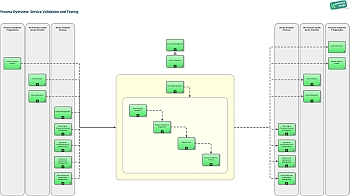Service Validation and Testing

ITIL Service Validation and Testing: Overview
Process Objective: To ensure that deployed releases and the resulting services meet customer expectations, and to verify that IT operations is able to support the new service.
Part of: Service Transition
Process Owner: Test Manager
ITIL Service Validation and Testing: Process Definition

Service Validation and Testing is new process in ITIL V3; ITIL V2 covered some aspects of Release testing within Release Management but ITIL V3 provides considerably enhanced guidance. Major additions in ITIL V3 are details on the various testing stages during Service Transition and descriptions of the corresponding testing approaches.
The following sub-processes are part of Service Validation and Testing according to ITIL V3:
Sub-Processes
- Test Model Definition
- Process Objective: To specify in detail how the Release will be tested and quality-assured. In particular, this process defines the testing concept and specific test cases to be used during Service Validation.
- Service Design Validation
- Process Objective: To ensure that an IT service meets its functionality and quality requirements and that the service provider is ready to operate the new service when it has been deployed.
- Release Component Acquisition
- Process Objective: To acquire the components of a Release and submit them to an initial assessment. This process ensures that only components which meet stringent quality criteria are allowed to enter the intensive testing phase.
- Release Test
- Process Objective: To test all Release Components and all tools and mechanisms required for deployment, migration and back out. This process ensures that only components which meet stringent quality criteria are deployed into the live productive environment.
- Service Acceptance Testing
- Process Objective: To verify if all conditions are met for the new service to be activated, and to obtain a binding consent from the customer that the new service fulfils the agreed Service Level Requirements.
ITIL Terms: Service Validation and Testing
- Development/ Install. QA Documentation
- A documentation of tests and quality assurance measures applied during the development or installation of applications, systems and other infrastructure components (e.g. component tests, code walk-throughs, ...). A complete Development/ Installation QA Documentation testifies that the required QA measures were applied prior to handing a Release component over to Release Management.
- Service Design Validation Report
- A report summarizing the results of the Service Design Validation testing activities, documenting that the Service Design Package correctly matches the Service Requirements.
- Testing Script
- A detailed set of instructions for testing certain aspects of an application or infrastructure item. The Testing Script essentially defines the activities to be carried out and the expected outcomes.
- Test Model
- A Test Model is created during the Release planning phase to specify in detail the testing approach used for deploying a Release into the productive environment. It is an important input for the Project Plan. Most importantly, this document defines the required quality assurance checkpoints during the Release deployment.
- Validation Test Report
- A Validation Test Report summarizes the results of testing and assessment activities, documenting that the assessed Release components successfully passed a validation stage.
Additional Information on Service Validation and Testing
ITIL KPIs
ITIL Roles in Service Validation and Testing
- Test Manager - Process Owner
- The Test Manager ensures that deployed Releases and the resulting services meet customer expectations, and verifies that IT operations is able to support the new service.
- Compliance Manager
- The Compliance Manager's responsibility is to ensure that standards and guidelines is followed, or that proper, consistent accounting or other practices are being employed.
- This includes to make sure that external legal requirements are fulfilled.
- Customer
- Someone who buys goods or services.
- The Customer of an IT Service Provider is the person or group who defines and agrees the service level targets.
- IT Security Manager
- The IT Security Manager is responsible for ensuring the confidentiality, integrity and availability of an organization’s assets, information, data and IT services.
- He is usually involved in an organizational approach to Security Management which has a wider scope than the IT service provider, and includes handling of paper, building access, phone calls etc., for the entire organization.
- Release Manager
- The Release Manager is responsible for planning, scheduling and controlling the movement of Releases to test and live environments. His primary objective is to ensure that the integrity of the live environment is protected and that the correct components are released.
- Service Level Manager
- The Service Level Manager is responsible for negotiating Service Level Agreements and ensuring that these are met.
- He makes sure that all IT Service Management processes, Operational Level Agreements and Underpinning Contracts are appropriate for the agreed service level targets.
- The Service Level Manager also monitors and reports on service levels.
- User
- The user of an IT service on the business side.






